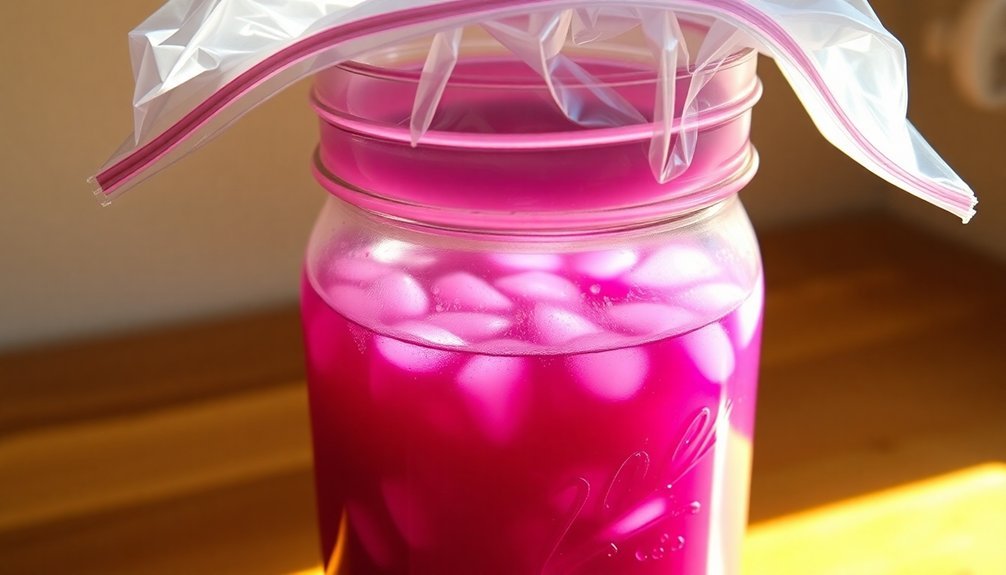You'll save money and time with these three proven DIY airlock methods for home fermentation. The simple water lock uses a rubber stopper and airlock device filled halfway with water, acting as a one-way valve for CO2 escape. The double-jar system connects two vessels with tubing and a nylon barb, creating an effective barrier against contamination. For a beginner-friendly option, try the zip-top bag method – just combine your ingredients in a resealable bag and watch it inflate as fermentation occurs. Each technique offers unique advantages, and there's much more to discover about maximizing your fermentation results.
Simple Water Lock Setup

A fermentation setup's most essential component is its airlock system, which you can easily assemble at home.
You'll need a fermentation vessel, an airtight lid, a rubber stopper or grommet, an airlock device from your local homebrew store, and water to create an effective barrier against unwanted air. Adding molasses and EM1 helps kickstart the fermentation process.
Start by drilling or punching a hole in your vessel's lid that matches your rubber stopper's size. Insert the grommet or stopper firmly into the hole, then push your airlock through it. Fill the airlock with clean water up to its marked fill line – typically halfway full. This water creates a one-way valve that lets carbon dioxide escape while blocking outside air from entering.
You'll know your setup is working when you see bubbles forming in the airlock as CO2 escapes during fermentation.
Check the seal around your lid and airlock regularly to prevent air leaks. Monitor the bubble frequency to track fermentation progress – when bubbles slow to once per minute, your fermentation is nearly complete.
Remember to maintain proper water levels in your airlock throughout the process to guarantee consistent protection against contamination.
Double-Jar Fermentation System
Through an ingenious combination of household items, the double-jar fermentation system creates a reliable airlock without specialized equipment. You'll need two jars, tubing, and a nylon barb or pen top to construct this effective setup that manages CO2 release while maintaining anaerobic conditions. For optimal results, consider using wide-mouth mason jars which offer easier access and cleaning.
| Component | Function |
|---|---|
| Airlock Jar | Holds water to prevent air backflow |
| Tubing | Connects both jars and allows gas escape |
| Nylon Barb/Pen Top | Creates airtight seal in lid |
To set up your system, drill a precise hole in the fermentation jar's lid and secure the nylon barb or pen top with hot glue. Add smaller holes around the main opening for additional gas escape. Insert the tube through the barb and make sure it's submerged in the water-filled airlock jar.
This system eliminates daily burping and greatly reduces the risk of contamination. You'll find the materials at any hardware store, making it a cost-effective alternative to commercial airlocks. The setup's durability means you can reuse it for multiple fermentation projects, and it's adaptable to various jar sizes. Remember to maintain the water level in your airlock jar to guarantee proper functionality.
Zip-Top Bag Method

The zip-top bag method offers three key advantages for home fermentation: simplicity, cost-effectiveness, and visual feedback.
You'll need just a snack-sized resealable bag, your chosen feedstock, yeast, and warm water to get started. Using filtered water will ensure optimal fermentation results.
To set up your airlock, combine one teaspoon each of feedstock and yeast in the bag, then add 1/4 cup of warm water (around 40°C). Remove as much air as possible when sealing the bag, and mix the contents gently before laying it flat.
You'll see the fermentation process in action as CO2 production causes the bag to inflate.
Keep an eye on your bag's expansion and release excess gas if needed to prevent bursting. You can track fermentation progress by measuring the bag's height with a ruler at 5-minute intervals. Within 20-30 minutes, you'll typically reach maximum inflation.
You can experiment with different feedstocks to compare fermentation rates or add tools like ethanol probes for more detailed measurements.
This method works particularly well for testing various materials and understanding the relationship between time and fermentation activity.
Frequently Asked Questions
Can I Reuse Airlocks Between Different Fermentation Projects?
Yes, you can reuse airlocks between fermentation projects. Just make certain you're thoroughly cleaning and sanitizing them after each use. It's best to inspect them for damage and verify they're completely dry before reusing.
How Often Should I Change the Liquid in My Airlock?
You don't need to change your airlock liquid on a fixed schedule. Just replace it when it's cloudy, contaminated, or contains visible debris. If you spot fruit flies or sediment, change it immediately.
What's the Maximum Temperature My DIY Airlock Can Safely Handle?
You'll want to keep your DIY airlock below 80°F for ideal safety. While it can handle higher temperatures briefly, staying within 65-75°F guarantees your materials remain stable and your fermentation stays safe.
Will Cold Temperatures Affect My Airlock's Performance During Winter Fermentation?
Your airlock will function mechanically in cold temps, but you won't see much activity since fermentation slows below 40°F. Keep your fermentation at 70-75°F for best results, regardless of airlock type.
Can I Use Glycerin Instead of Water or Vodka in My Airlock?
Yes, you can use glycerin in your airlock. It's actually a great choice since it won't evaporate quickly, has antimicrobial properties, and doesn't need frequent refills like water or vodka do.
In Summary
You've now learned three effective DIY airlock methods that'll save you money while keeping your ferments safe. Whether you choose the simple water lock, double-jar system, or zip-top bag method, you'll achieve successful fermentation without buying specialized equipment. Start with whichever method matches your available supplies, and don't hesitate to experiment with different techniques as you become more comfortable with home fermentation.





Leave a Reply